African violets are a common houseplant that thrives under favorable conditions. But they can face various problems if you do not provide them with proper care. If you are struggling to keep your African violets alive and every time you get an African violet, it ends up dying then you are at the right spot.
In this article, we shall share with you the perfect solution to save a dying african violet.
To save a dying African violet, you need to follow the following steps:
- Move the plant to a brightly lit spot.
- Inspect the plant for signs of damage.
- Prune any damaged leaves and flowers.
- Check the plant roots. If they are brown and mushy, then you will not be able to save the plant.
- If the roots are white and healthy, you can repot your African violets.
- Use a well-draining soil mix and repot the plant.
- Water only when the topsoil gets a little dry.
- Do not fertilize the plant until it shows a sign of recovery. Later fertilize the plant once a month.
If you want to solve this problem, you need to understand the exact reason behind why your plants are wilting and treat them accordingly.
This article will tell you why your African violets are wilting and how you can help them recover.
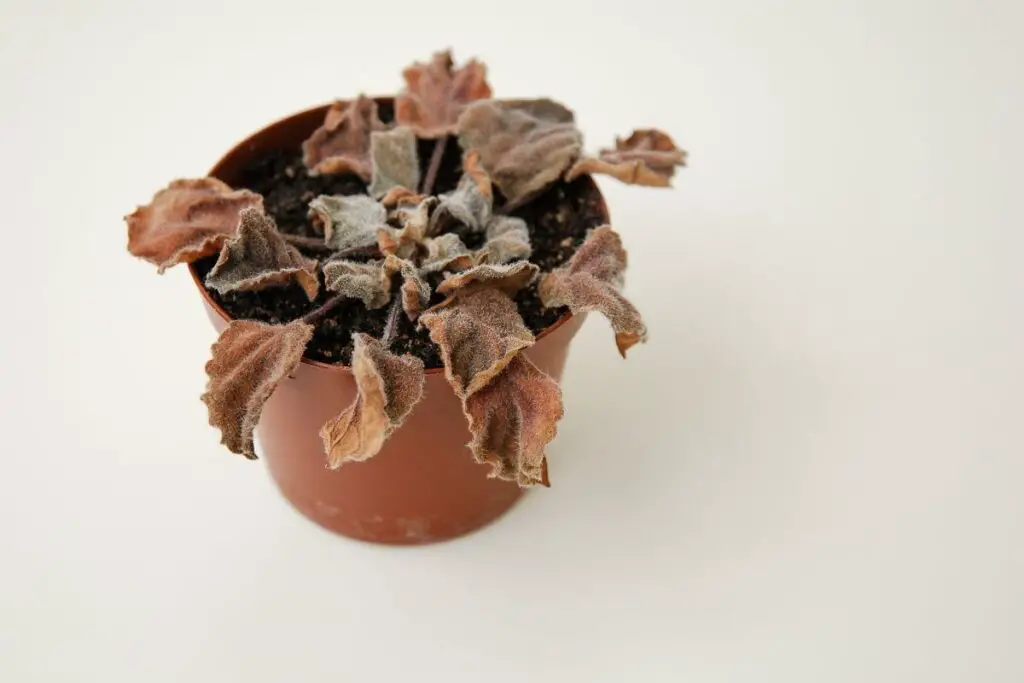
Why are my African violets dying?
African violets may undergo wilting due to different reasons. Some common reasons are:
- Underwatering
- Overwatering
- Overfertilization
- Excess heat
- Low temperature
- Low humidity
- Root rot disease
- Pest infestation
You must understand all these to take the required actions to recover your plant from wilting. Now let us discuss each cause in detail along with their solutions.
Underwatering
African violets prefer to stay in slightly moist soil, which should not go completely dry.
If the soil gets less moisture, the roots will not be able to transfer water and minerals to the stems and leaves of the plant, hampering all the plant’s internal processes.
The leaves get dehydrated and turn brown, and begin to wilt if they stay without water for a longer period. Due to underwatering, your plant can stress out, so it is vital to water them adequately to keep them healthy.
Solution
Solve this by following these steps:
- Water your African violets every other day if the weather is extremely dry.
- While watering, allow the water to soak the soil thoroughly and let the excess water drain out.
- Avoid excessive heat as hot conditions can significantly increase evaporation from the soil.
- Check the soil every few days to observe the water requirements of the plants.
Also read: How Often Should African Violets Be Watered? (African Violet Water Requirements)
Looking for gardening supplies? We have tested 100's of products before recommending them to you guys. Check out our best pick below:
| Image | Gardening Supplies | Best Price? |
|---|---|---|
 Top
Top Top
Top | Raised Garden Bed Kit | Check On Amazon |
 | XLUX Soil Moisture Meter, Plant Water Monitor, Soil Hygrometer Sensor for Gardening, Farming, Indoor and Outdoor Plants, No Batteries Required | No Results |
 Top
Top Top
Top | 82 Pcs Garden Tools Set and Extra Succulent Tools Set | Check On Amazon |
 | Joeys Garden Expandable Garden Hose with 8 Function Hose Nozzle, Lightweight Anti-Kink Flexible Garden Hoses, Extra Strength Fabric with Double Latex Core, (50 FT, Black) | No Results |
 Top
Top Top
Top | Dual Chamber Compost Tumbler | Check On Amazon |
 Top
Top Top
Top | Sunnyglade Plant Stakes | Check On Amazon |
 Top
Top Top
Top | Organic Cold Pressed Neem Seed Oil | Check On Amazon |
 Top
Top Top
Top | Mighty Mint Gallon :-Insect and Pest Control Peppermint Oil | Check On Amazon |
 Top
Top Top
Top | Scotts DiseaseEx Lawn Fungicide | Check On Amazon |
 Top
Top Top
Top | Jacks Classic 20-20-20 All Purpose Fertilizer | Check On Amazon |
 Top
Top Top
Top | 30,000 Seeds Pollinator Attracting Wildflower Mixture | Check On Amazon |
 Top
Top Top
Top | Survival Vegetable Seeds Garden Kit-Over 16,000 Seeds | Check On Amazon |
Overwatering
Overwatering is a common cause of wilting of leaves in your plant. If the soil is too soggy, the growth of the plant will stop. African violets don’t like to stay in water for a long time. The leaves wilt if the soil is too wet.
If there are waterlogging conditions in the soil, roots will not get enough oxygen, and that can cause root rot disease. Root rot will destroy the roots of a plant and cause the plant to wilt.
Root rot mainly happens when the plant suffers from a poor drainage system or the soil is exposed to water for too long.
Solution
Use the following steps given below:
- Check the soil’s moisture level before watering your African violets.
- Insert the finger 1-2 inches into the soil and check the tip. If you find the soil is wet, it means the soil has enough moisture, and you should not water your African violets yet.
- Provide the African violets with at least 4-6 hours of indirect light to prevent overwatering.
- Remove the dead and dying roots and keep only the healthy ones.
- Create an additional spacing between the roots to allow oxygen to reach the root zone.
- Water the African violets when the soil is completely dry.
Overfertilization
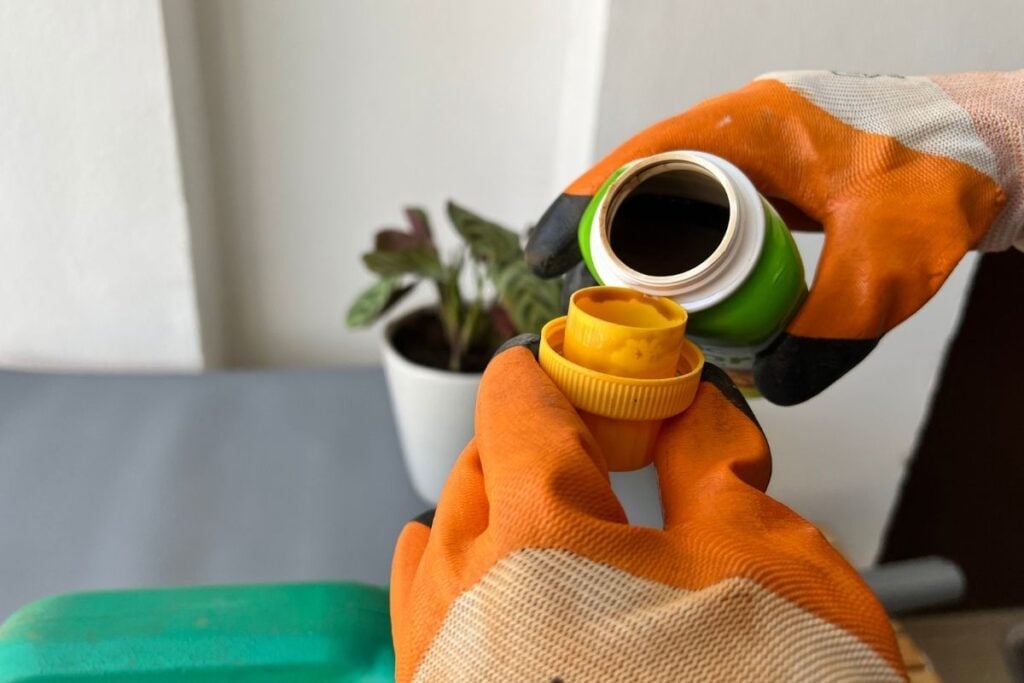
Overfertilization can create various problems for African violets. Excess fertilizer can prove to be toxic as these plants only need some fertilizer to prevent nutrient deficiencies.
Due to excessive fertilization, the chemicals damage the roots. Because of injured roots, the plant finds it difficult to absorb water which can cause wilting of leaves in African violets.
Burned and dry leaves are the most common symptoms of over-fertilization in African violets, which makes it easy to identify whether you have added excess fertilizer to your plant.
There should be a proper balance of fertilization in plants to avoid wilting of leaves.
Solution
- Flush the soil to remove the excess fertilizers present in the soil.
- Immerse the soil in water until it drains out from the bottom of the container and let the water run for 30 minutes.
- Repeat this cycle 1 to 2 times.
- You can also replant your African violets in a new pot with fresh soil.
- Always use a liquid fertilizer and add enough water to them to avoid over-fertilization.
- Don’t fertilize your Africa n violets until they look healthy again.
Also read: What Kind Of Fertilizer Is Good For African Violets? (+Best Picks)
Excess heat
Giving excess heat to your African violets can damage their tissues as they are susceptible to direct sunlight and high temperatures. These lead to an increase in the process of transpiration, which results in water loss in plants.
An increase in the water demand will lead to wilting of leaves in your African violets. Browning, drying, curling, and falling leaves are other signs of excess heat and sunlight.
Exposing this plant to direct sunlight can be deadly, so proper care and attention are required in such conditions.
Solution
- Move your African violets to a shaded area of the room.
- Avoid sunny windows and doors to protect your plant from direct sunlight.
- Provide them with a proper watering schedule and always keep the soil moist.
- Mulch the soil to keep it moisturized.
Also read: Can African Violets Grow Outside? (+Outdoor Care)
Low temperatures
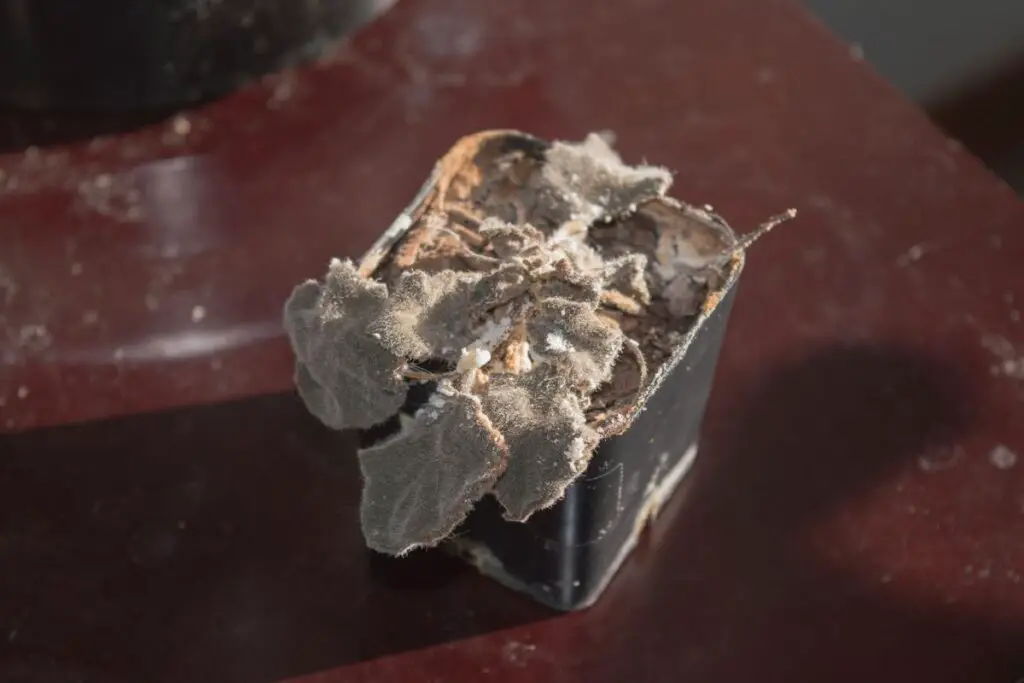
Low temperatures can cause direct damage to the foliage and roots of African violets. When the roots get damaged, African violets fail to absorb water, and their leaves wilt.
The ideal temperature for African violets should be between 65-80°F.
But if the temperatures drop below 60°F, African violets begin to wilt and die.
It becomes difficult to grow them properly in low temperatures as they develop various problems.
Solution
- Reduce the watering rate in low temperatures and always check the soil’s moisture level before watering your African violets.
- Provide bright indirect sunlight the whole day.
- If possible, maintain the ideal temperature between 65-85°F.
- You can maintain the temperature inside your home with a thermostat device.
- Spread at least 2 to 3 inches of mulch around the soil surface to protect your African violets from lower temperatures.
Also read: African Violet Winter Care: Lighting, Watering, Fertilizing & More
Low humidity
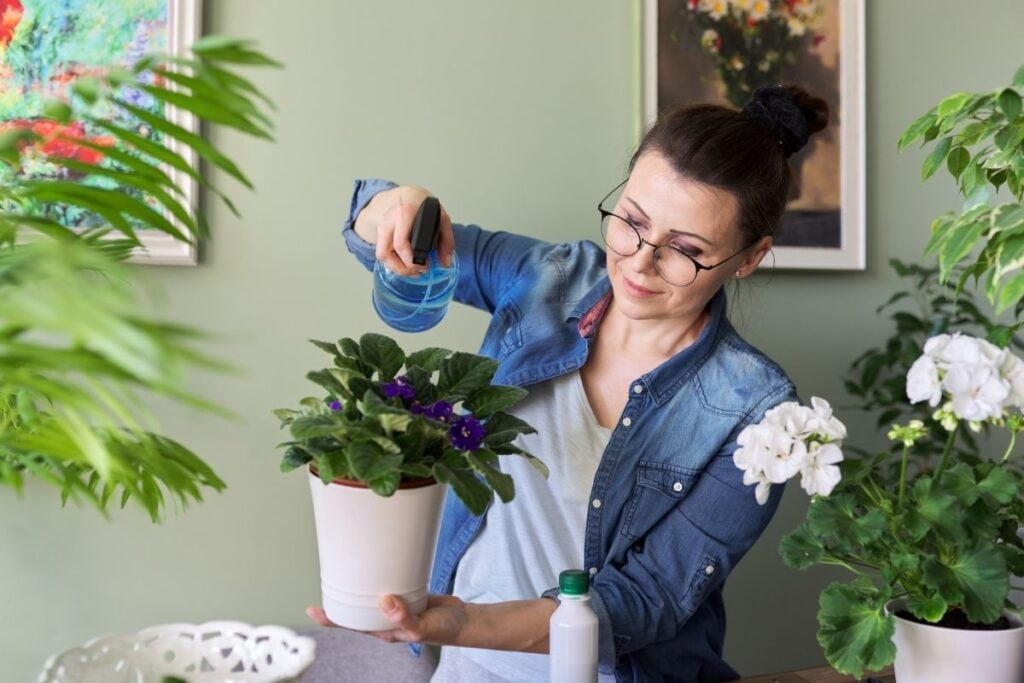
African violets require a humidity range between 50% and 60%. If the humidity goes below 50%, it will be too dry and difficult for them to survive.
When the humidity is low, the plant starts to lose water through its leaves by transpiration, and then they experience dehydration. Due to dehydration, the roots fail to supply moisture to the plant, which results in wilted leaves.
African violets mostly experience low humidity problems during the winter months as the air becomes very dry, so they require proper care.
Solution
- You can use a humidifier to maintain humidity levels inside your house for African violets.
- Keeping your other plants with African violets can also increase the humidity levels in that area.
- You can create a humidity tray by putting pebbles and water in a drip tray and placing your potted African violets on top of the tray.
- Spraying water on your plant with a spray bottle will help in maintaining humidity.
- Don’t place your African violets near radiators and other heating sources as the humidity level is less in those areas that can cause burns.
Also read: Do African Violets Like Misting? (+Humidity Guide)
Root rot disease
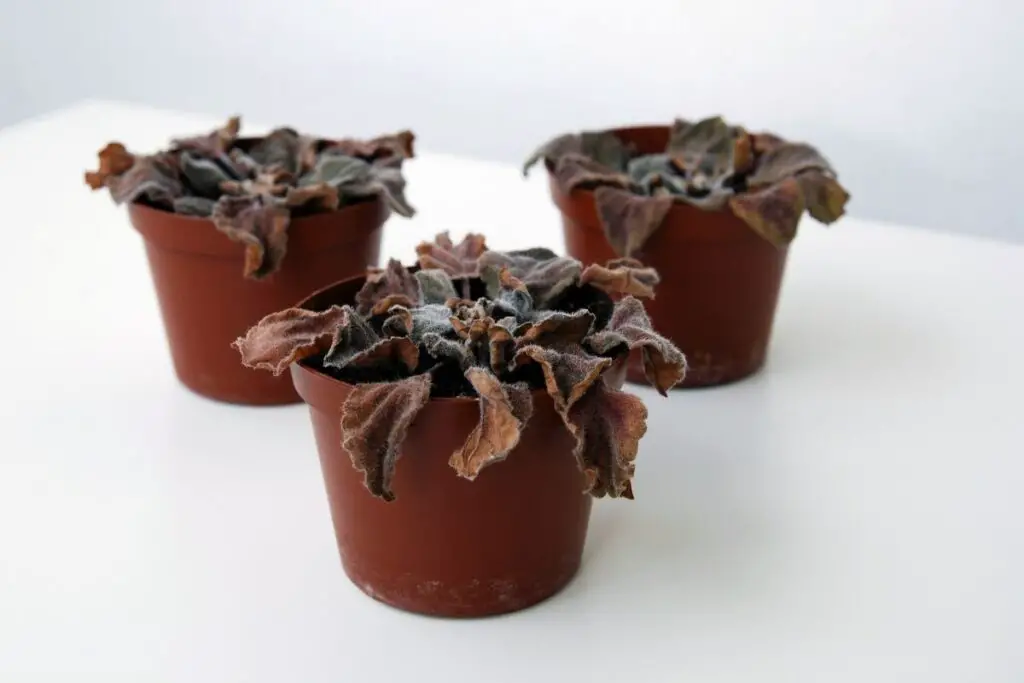
Root rot is the most common cause for wilting of leaves in African violets. This disease mainly happens because of waterlogging. You should water your African violets only when they need it. Too much water is not suitable for these plants.
Due to waterlogging, the roots suffocate, and various fungi infestations and pathogens start to grow in the soil leading to root rot.
Root rot can also happen due to overfertilization in African violets. Excess chemicals in the soil and can cause injury to the roots. It can be challenging to fix root rot, especially in severe conditions, and the plant might die.
Solution
- Take out the African violet from the pot.
- Remove the soil by washing the roots and eliminate all the damaged roots by cutting them with scissors.
- Repot your plant in a large pot and replace the used soil with a new one.
- Water your African violets only when required.
- Provide your African violets with a sound drainage system to drain the excess water from the soil.
- Avoid fertilizing your African violets when they are recovering.
Pest infestation
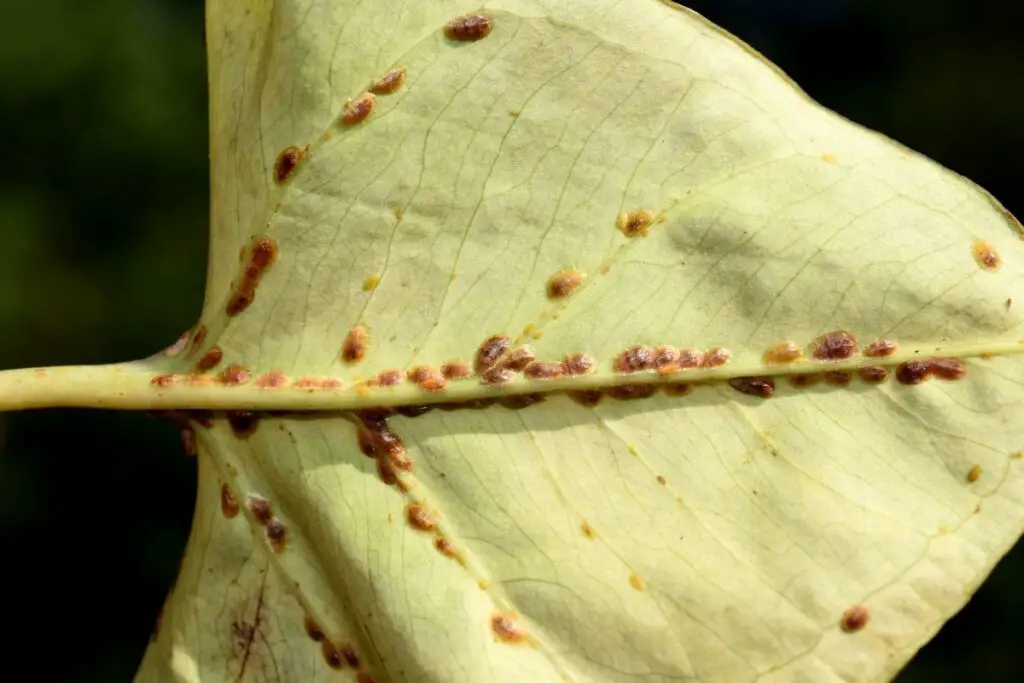
Pests that suck out the sap from the African violets can cause problems like wilting leaves. It happens because these pests reduce the water level in African violets.
Sap sucking pests include mealybugs, aphids, spider mites, thrips, and scales. If any pests attack your African violets in large amounts, they can cause severe injury to your plants.
They damage the entire plant and make the plant weak, leading them to have distorted and wilting leaves.
If the leaves of the African violets are wilting, you should immediately check whether pests have attacked them or not, and if yes, remove them as soon as possible.
Solution
- Soak cotton balls in alcohol and apply them to the areas where you notice the pests.
- Take 1 cup of isopropyl alcohol and a few drops of dish soap and mix it with one-quarter water.
- Pour this into a bottle and spray the entire plant, including leaves and stems.
- You can also wash the African violets with a strong spray of water to remove pests.
- You can use soap and water mixture, horticulture oil, and insecticidal soap while spraying.
- Take 1 teaspoon of organic mild liquid soap and mix it in 1 liter of water. Spray on the scales and leaves of your African violets.
- Repeat this twice a week till you notice an improvement.
Also read: How To Get Rid Of Bugs On African Violets? (Signs+Treatment)
Final words
With proper care, you can prevent wilting of leaves on African violets.
- Maintain a proper watering schedule to prevent your African violets from wilting.
- Provide at least 4-6 hours of indirect sunlight to the African violets.
- Always prune the injured leaves of your African violets to keep the other leaves healthy.
- Avoid fertilizing your plant while they are still recovering from damage.
Also read: Why Is My African Violets Not Blooming? (Causes+How To Fix)
Source: Wikipedia, African violet: Classical breeding, African Violet Society of America, In vitro propagation of African violet, University of Florida, North Dakota State University, The University of Georgia.

Your point of view caught my eye and was very interesting. Thanks.